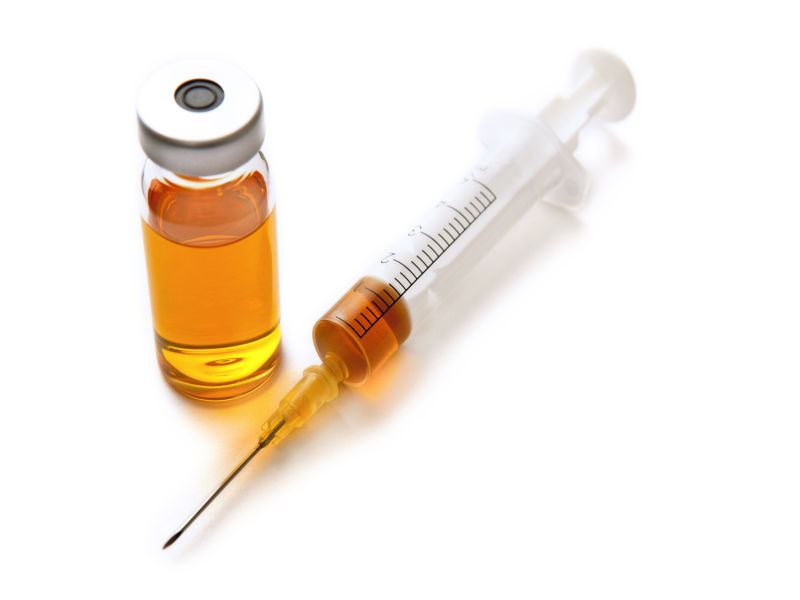 By Amy Norton
By Amy Norton
HealthDay Reporter
THURSDAY, Feb. 15, 2018 (HealthDay News) — In what researchers call a first step toward personalized vaccines for a multitude of cancers, a vaccine made from stem cells protected mice from tumors.
The vaccine was composed of induced pluripotent stem cells (iPS cells) — which are adult cells that have been reverted back into stem cells. They are similar to the primitive cells found in embryos, and they have the potential to develop into any type of body tissue.
Researchers have been studying iPS cells as a way to treat various diseases. The general idea is to take cells from an adult patient — from the skin, for instance — then genetically tweak them so they “rewind” into iPS cells. Those cells could then be used to generate healthy replacement tissues for those damaged by disease or injury.
But it turns out that iPS cells also have similarities to tumor cells, explained senior researcher Dr. Joseph Wu, a professor at Stanford University School of Medicine.
Specifically, both iPS cells and cancer cells share various antigens — or proteins — on their surfaces.
So, Wu and his colleagues decided to see if iPS cells could serve as a vaccine against cancer: If the immune system is exposed to the cells, would it be primed to recognize and attack any tumor cells that later arise?
They found that, at least in lab mice, the concept worked.
“This is obviously just a first step,” stressed Dr. Nigel Kooreman, who also worked on the study.
No one knows if the premise will pan out in humans. The next step will be to test the approach in human cells in the lab dish, according to Kooreman, who was a postdoctoral scholar at Stanford at the time of the study.
The results, published Feb. 15 in the journal Cell Stem Cell, come on the heels of another cancer vaccine study conducted by some of the same researchers.
In that trial, a shot of two compounds stimulated the immune system to seek and destroy several different kinds of cancer cells — again, in mice.
The hope with the latest research, Kooreman said, is to eventually create personalized vaccines from an individual’s own iPS cells that could protect against a range of cancers.
“I think this is a really exciting study,” said Dr. Sasha Stanton, of the University of Washington’s Cancer Vaccine Institute in Seattle.
There are, of course, many unanswered questions, according to Stanton, who was not involved in the research.
Any vaccine used for cancer prevention would have to be “very, very safe,” she pointed out.
With iPS cells, Stanton explained, there is always some concern that they could develop into tumors.
Beyond that, she said, there will be questions about how long would any immune response from vaccination would last. Would it protect people from cancer for 20 years, or would repeat “boosters” be needed, Stanton wondered.
But these initial findings are promising, Stanton said.
For the study, Wu’s team used four groups of mice: In one, the animals were injected with a control solution; another received an immune-boosting substance called an adjuvant; a third group received injections of iPS cells that were genetically matched to each animal; the fourth received iPS cells plus the adjuvant. All of the animals were later implanted with mouse breast cancer cells.
While those tumors grew in most of the animals, the picture was different for mice that received iPS cells plus the adjuvant: Breast tumors shrunk in 7 of the 10 animals, and two completely rejected the cancer, the researchers said.
Similar results were seen when mouse versions of melanoma and mesothelioma (a type of lung cancer) were studied.
What happens to the iPS cells after they are injected into the body? The immune system destroys them, Kooreman said.
And before the iPS cells were infused into the animals, they were treated with radiation. That, Kooreman explained, was to prevent them from developing into tumors.
Another safety concern is that iPS cells could trigger an immune response against the body’s healthy tissue. But there were no signs of that in the lab mice, according to Kooreman.
“So far, in our preclinical studies of mice, it appears safe,” he said.
If a preventive cancer vaccine can be developed for humans, how would it be used?
At first, Stanton said, it could be used to prevent recurrences in patients successfully treated for cancer.
Kooreman added an iPS cell vaccine could also potentially aid cancer treatment.
He envisioned it working this way: After a patient receives an initial cancer therapy, the vaccine could be used to “reactivate the immune system to attack any remnant cancer cells.”

Copyright © 2018 HealthDay. All rights reserved.
SOURCES: Joseph Wu, M.D., Ph.D., professor, cardiovascular medicine and radiology, Stanford University School of Medicine, Stanford, Calif.; Nigel Kooreman, M.D., surgical resident, MCH-Bronovo, The Hague, Netherlands, and former postdoctoral scholar, Stanford University; Sasha Stanton, M.D., Ph.D., assistant professor, University of Washington Cancer Vaccine Institute, Seattle; Feb. 15, 2018, Cell Stem Cell, online
[the_ad id=”28610″]





Leave a Reply